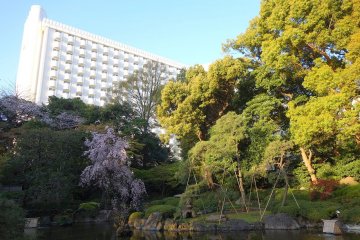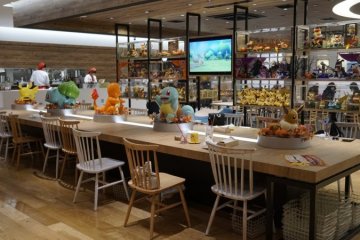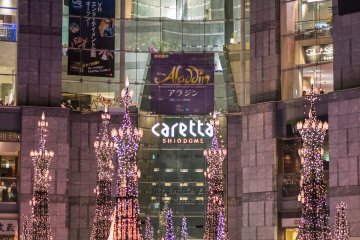

挖掘东京历史最悠久,最吸人眼球的庭院,汐留的巨大清晰的庭园为了我们提供了一个鲜明的对比。在江户时代(1602-1867),当时浜離宮恩赐庭园曾经是古代日本天皇的居住地。而现在,作为一个高人气的景点,无论是游客还是本地居民,访客络绎不绝。
东京一直以来都以新旧建筑物的鲜明对比而闻名,而汐留的高楼更加强化了那种对比。汐留的庭院大致分为2部分,南部庭院曾经是古代天皇的花园,北部庭院在明治时代之后修建完工。
北部庭院的古典梅花,300年历史的古乔树都很值得观赏。南部庭院内有潮入之池和两处猎鸭场都是非常有代表性,除此之外,外部休息处可以眺望美丽的远景。
值得特别一提的事,滨离宫恩赐庭园的潮入之池将海水导入庭园中的水池,利用潮汐的涨落使得水池产生不同的情趣。这些镜子状的池的水面随着东京湾的潮汐而变动。然后这其实是当年江户时期修建这个庭院的人们不小心制造的偶然,以至于这个水池可根据四季的变化带来不同的贡献。
Oedo Subway line to Shiodome Station

Oakwood Premier Tokyo comes from a brand of standout luxury hotel & service apartments right at the heart of the Tokyo metropolis. It is located in the business hub of Marunouchi with JR Tokyo Station in close proximity. This will allow guests and travelers to easily access the city's extensive transport network and visit various landmarks such as Imperial Palace, Tsukiji Fish Market, Ginza and Shopping District. Boasting 123 luxurious apartments on the upper floors of a multi-serviced complex, each room offers a magnificent view of the city, not to mention all furnished and a fully-equipped kitchen set which is rarely seen in your everyday service apartment. Without doubt, these spacious tranquil retreats are curated to give you the amenities and services of a luxury hotel and a feeling of home. They are good options for both business executives and leisure travelers from one night of a short-stay to a few weeks/months of mid-to-long-term stay.

ANA Holiday Inn Tokyo Bay (previously Dai-ichi Hotel Tokyo Seafort) is a 132-room hotel that will provide visitors to Japan’s capital city with an attractive, fresh option in the midscale space. ANA Holiday Inn Tokyo Bay will join a strong portfolio of 10 ANA Holiday Inn open and pipeline hotels across Japan, and become part of the brand’s global footprint of 1,234 open hotels and 278 pipeline properties.

Just minutes from Shinagawa Station, the Grand Prince Hotel New Takanawa is surrounded by lush greenery in the Takanawa area, with rooms offering balcony views of the nearby gardens and the surrounding Tokyo cityscape. This urban resort features convention facilities like the Hiten banquet hall, the international Convention Center Pamir, as well as a wide variety of Japanese, Chinese and Western restaurants.

The Pokémon Café in Nihonbashi, which opened in March 2018, is the latest character café in the popular series of games and series in Tokyo. The café and the adjacent Pokémon Center DX store were opened in 1997 on the occasion of the 20th anniversary of the first store. The bright café, which is furnished in warm wood tones, offers main courses, desserts and drinks - all of which are arranged with a focus on one or more Pokémon and some are suitable and limited to certain topics or seasons. You can also find exclusive merchandise here - from plush toys in chef jackets to bowls and cutlery with Pokémon motifs. They also sell Pikachu Sweets, special sweets and products with the most popular of all Pokémon as a motif. A visit to the Pokémon Café is only possible with a prior reservation, time slots can be selected from one month in advance and also in English via the website. It is located on the 5th floor of the Nihombashi Takashimaya Shopping Center, which is not far from the Tokyo and Nihonbashi stations.

Toyosu Market is a wholesale market in Tokyo located in the Koto District. It was built on man-made land in Tokyo Bay and replaces the historic Tsukiji Fish Market, which was previously the capital's famous fish market. Opened October 2018 and is the largest seafood market in the world. The market in turn consists of two separate fish markets, one for auctions and the other for general sale, plus a fruit and vegetable market. There are also restaurants and a variety of options for visitors. Tourists can watch the market from a viewing platform on the second floor and take part in guided auctions and events. However, it is no longer possible, as was previously the case in Tsukiji, for visitors to be directly at the famous tuna events, a platform was built for this, from which one can see into the interior of the market. The modern building complex also offers a roof terrace and a shrine and is easily accessible by bus and train.

If you're a fan of Quentin Tarantino’s Kill Bill, there's one Tokyo restaurant that absolutely deserves a spot on your bucket list. While you may not know it by its real name, chances are you've seen it on screen—it’s the unforgettable setting for the iconic, over-the-top showdown between The Bride and the Crazy 88. Known affectionately by fans as “The Kill Bill Restaurant,” this venue offers more than just cinematic nostalgia—it's a vibrant and unique dining experience in its own right. Located in Tokyo’s upscale Nishi-Azabu district, this classic-style izakaya bar is where fiction meets flavor. Though the fake blood and samurai swords have long been cleaned away, the spirit of the film lives on in the architecture and atmosphere. Stepping inside feels like walking onto the set: a grand, high-ceilinged hall with a central open-plan dining space, surrounded by a mezzanine-level balcony—instantly recognizable to anyone who’s watched the movie. But don’t mistake it for just a movie-themed attraction. The Kill Bill restaurant is a serious culinary destination. It offers a wide variety of traditional Japanese dishes, from sashimi and grilled skewers to noodle dishes and seasonal specialties. The menu also boasts creative fusion items like avocado and camembert tempura, which nods to the restaurant’s global popularity and mindset. And for international travelers with specific dietary needs, the restaurant provides vegan and halal-friendly menus (with at least three days’ notice). What makes this spot truly special is its ability to deliver a top-tier gourmet experience while doubling as a pop culture pilgrimage. You can sip sake where Uma Thurman once sliced through waves of enemies—minus the chaos, of course. Whether you’re a die-hard Tarantino fan, a foodie on the hunt for authentic Japanese flavors, or simply someone looking for a unique night out in Tokyo, this restaurant checks every box. Just one tip: Enjoy the drinks and dishes, but leave the swordplay to the professionals. Note: As you’d expect, Gonpachi is a popular restaurant. Same-day reservations are possible, but ideally you’ll want to reserve your table at least two days ahead of your visit, and even earlier if you’re planning to visit at the weekend.

Caretta Shiodome is a shopping and dining center in the Shiodome area of Minato-ku. It is not only home to cultural institutions such as the Tokyo Advertising Museum, but also offers unique shops and many restaurants with a variety of great dining experiences. There is also a theater a capacity of 1200 seats, where musicals are sometimes performed in Japanese. The restaurants are located 200 meters above the ground. Many restaurants on the 46th and 47th floors offer delicious dishes and fantastic views of Tokyo Tower, Tokyo Skytree, Rainbow Bridge and Ginza. Caretta Shiodome offers a wide range of events all year round, but one of the most exciting events is the impressive winter illumination. [Photo: Mahathir Mohd Yasin / Shutterstock.com]

Encounter all types of fresh foods and traditional Japanese foods in Tsukiji’s Outer Market. The market combines wholesale and retail shops into charm that lines the streets of the area and offers a unique perspective on Japan and even some original Japanese dishes. The Tsukiji Market was once a wholesale market for professionals and a place that tourists frequently visited. Particularly famous was the morning fish market where freshly caught fish would be cut and sold in large open areas of the market. Nowadays, the wholesale fish market has since moved to Toyosu (about 2 km away) back in 2018. However, this doesn’t mean that the Outer Tsukiji Market isn’t worth visiting. Colorful slices of fresh-sliced sashimi, dried seaweed, fruits, vegetables, single-servings of food, and kitchen utensils; you can find all this and more at the Outer Market in Tsukiji. In fact, many of the shops in the Outer Market simply bring their wares from Toyosu. In the Outer Market, there are buildings that are more than 80 years old. Many owners still use the first floor for their shops and live on the upper floors above street level creating an intricate maze of homes and shops. But even with this layout, Tsukiji Outer Market is a fascinating place to visit and shop. Especially for sushi and sashimi aficionados. The birth of the fish market as its known today began in 1657 when Edo was devastated by a great fire. Land was reclaimed from Tokyo Bay and named Tsukiji (築地), which means "constructed land". What was once a quiet living quarters for samurai families and shrines—one of which still sits at the back corner of the Tsukiji Market, "Namiyoke" offering protection from waves—became a hustling center of prosperous markets after the 1923 Great Kanto Earthquake. Even though half of the fish market has moved to Toyosu, the Outer Market remains a fascinating experience where tourists can rub elbows with locals and get a sense of where the fresh seafood of Tokyo comes from. The market typically opens for business at 9 am and goes on until 3 pm. This early closing time means that you want to get there early for the freshest foods before they sell out or are closed for the day. Tokyo's wholesale fish market moved to Toyosu in October 2018. Note that many shops are closed on Sundays and some Wednesdays.

Grand Hammer is a dynamic eight-story entertainment complex in Tokyo’s Shinbashi district, blending traditional Japanese culture with modern leisure. Opened in late 2024, it offers a diverse array of dining, performances, and relaxation options, making it a unique destination for both locals and tourists.